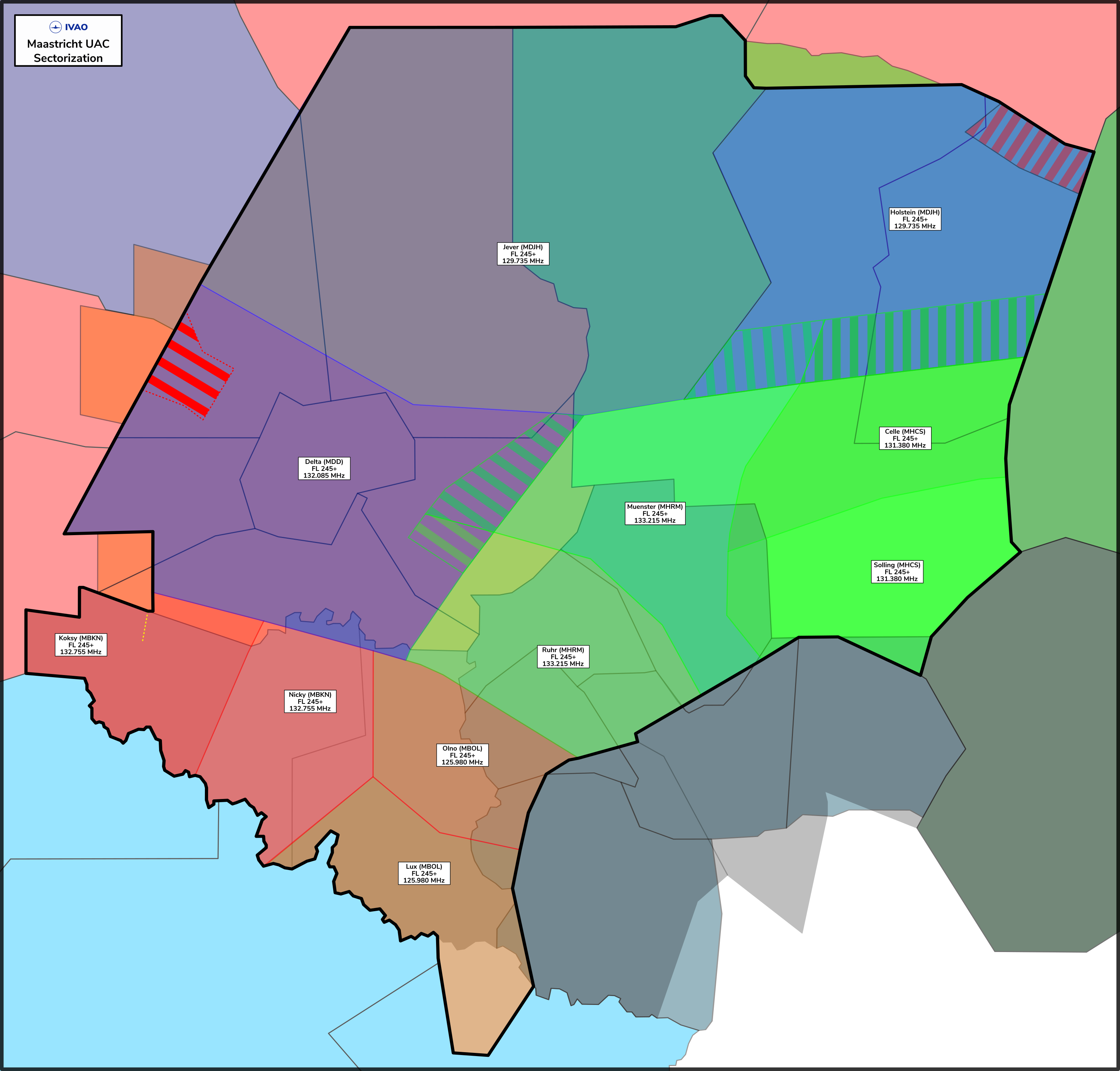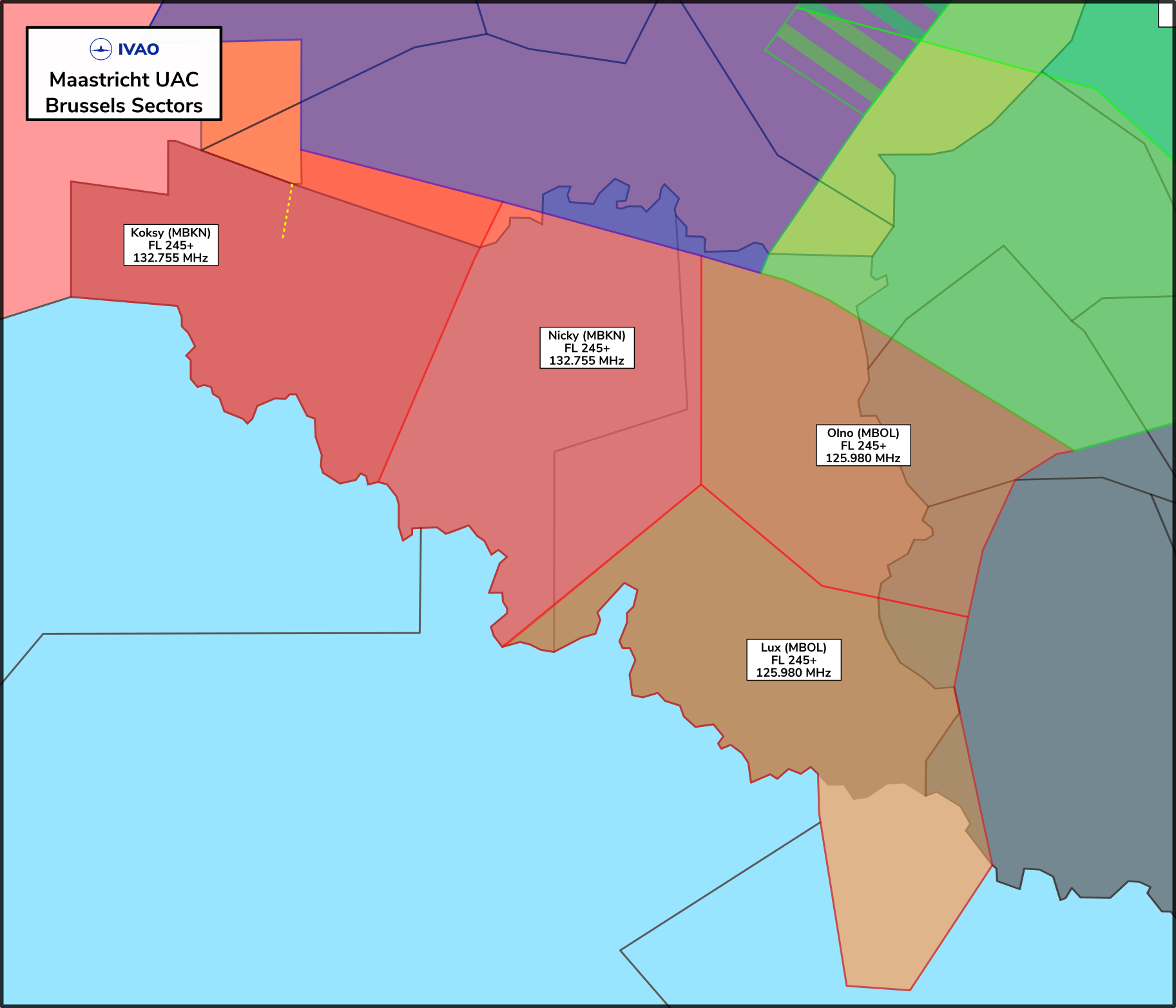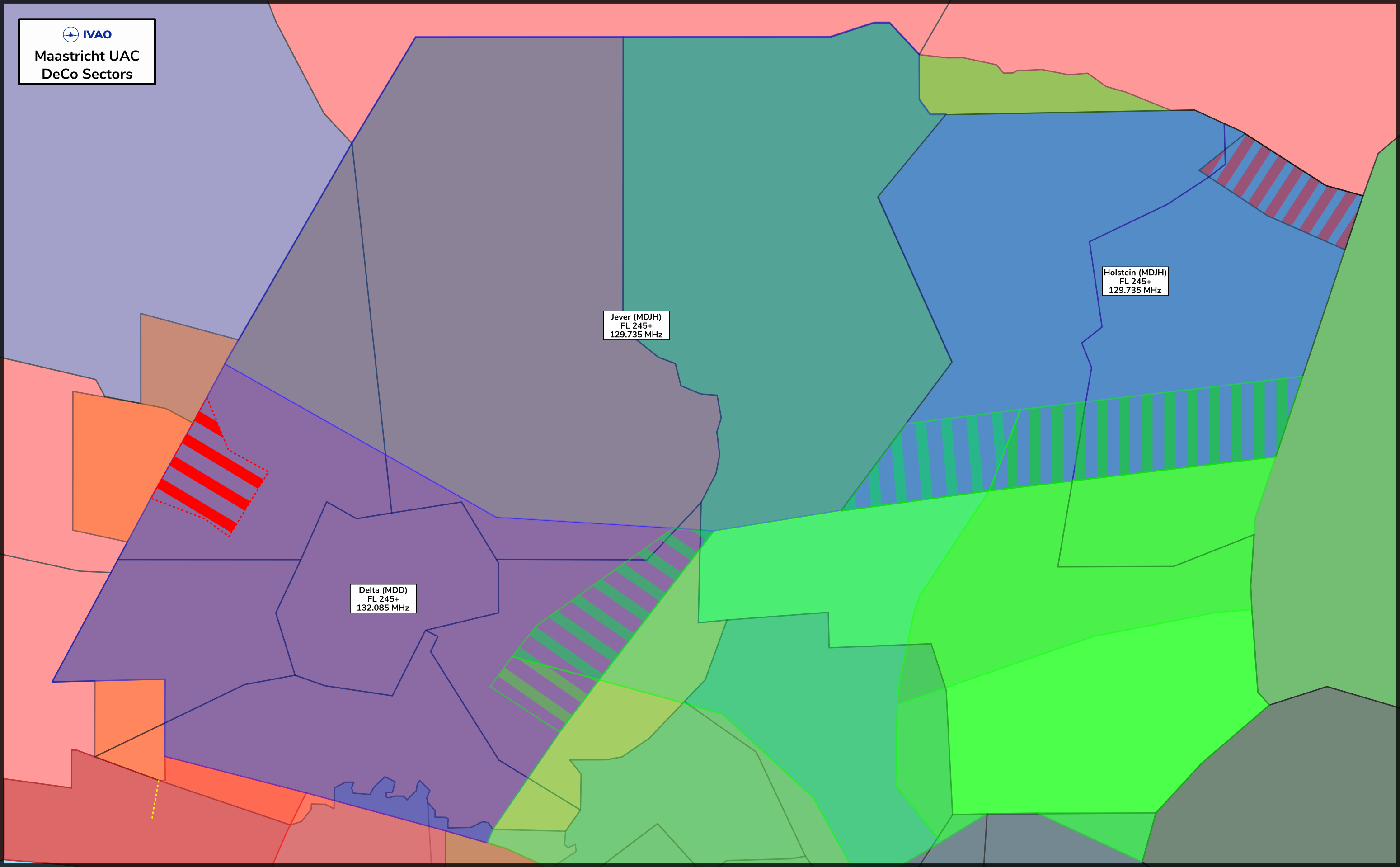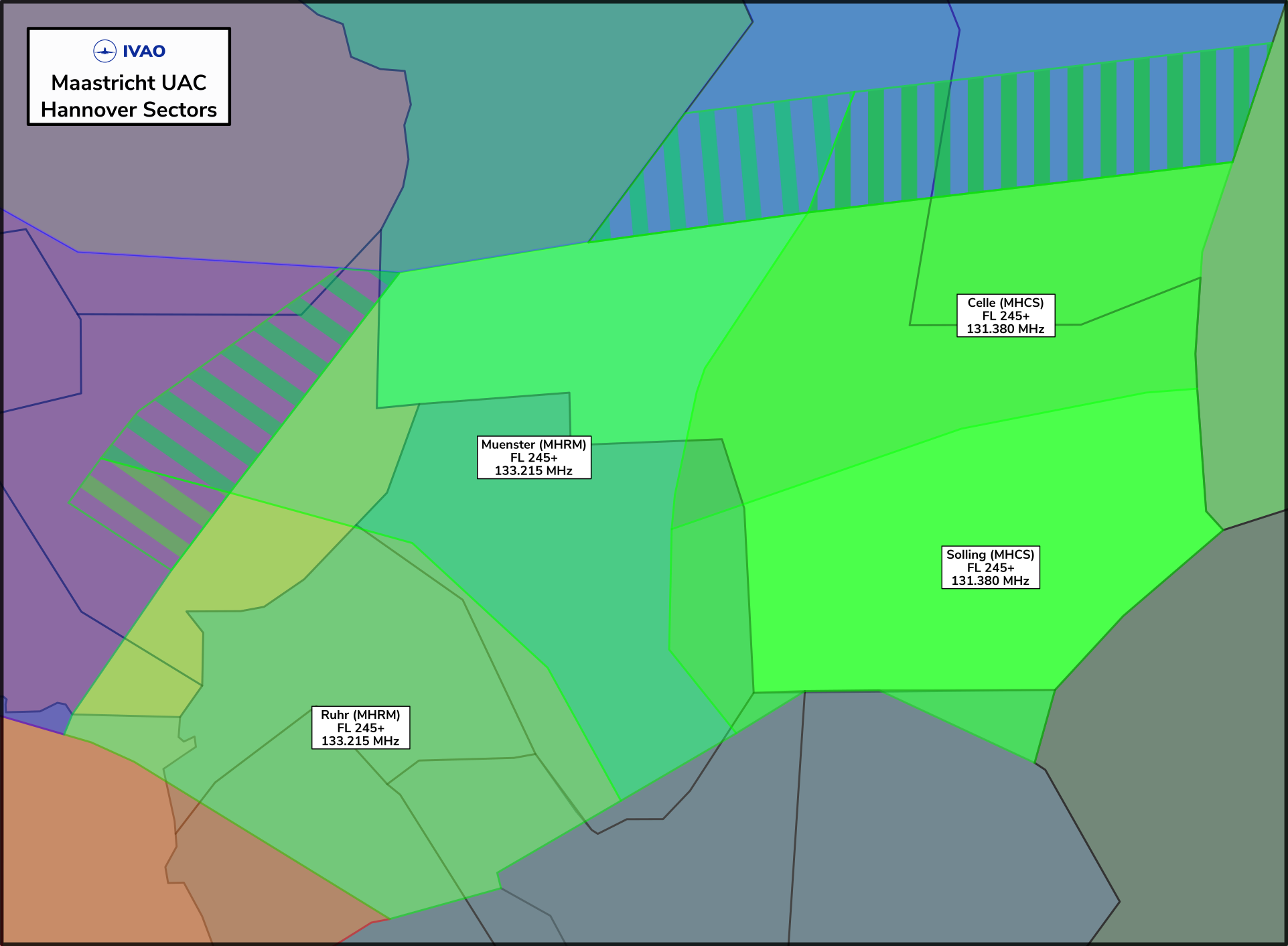Maastricht UAC Operations Manual
IVAO ATC HQ
¶ 1 Maastricht UAC Area of Responsibility
¶ 1.1 General
Maastricht UAC is responsible for the airspace of the Amsterdam FIR, the Brussels UIR and the Hannover UIR. Besides this, it also is responsible for a few bits of delegated airspace over France within the Paris UIR and over Germany within the Rhein UIR.

¶ 1.1.1 IFR Operations
Maastricht UAC is responsible for all IFR movements within the following airspace above FL245:
| FIR / UIR | Classification | Maastricht UAC levels |
| Amsterdam FIR | Class C from FL 195 to FL 660 | FL245 - FL660 |
| Brussels UIR | Class C from FL 195 to FL 660 | |
| Hannover UIR | Class C from FL 245 to FL 660 (Class C from FL 100 to FL 660 on airspace delegated from Bremen FIR and Rhein UIR) |
¶ 1.1.2 VFR Operations
VFR Operations are not permitted in the Maastricht UAC AoR, with the exception of OAT flights inside active Military Areas.
¶ 1.2 Sector groups
In Maastricht UAC, there are three sector groups, comprised of several sectors, all of them with Vertical Limits from FL 245 - FL 660.
- Brussels Sectorgroup:
- West Sectors:
- Koksy
- Nicky
- East Sectors:
- Olno
- Luxembourg
- West Sectors:
- DeCo Sectorgroup:
- West Sectors:
- Delta
- East Sectors:
- Jever
- Holstein
- West Sectors:
- Hannover Sectorgroup:
- West Sectors:
- Ruhr
- Münster
- East Sectors:
- Celle
- Solling
- West Sectors:
¶ 1.3 Sectorization
The Following Sector configurations are possible, involving both West and East Sectors. The sectors may be opened in any order with smaller sectors taking control of their respective area from the larger sector if online.
¶ 1.3.1 Full
¶ 1.3.1.1 Configuration F.1
Volume: MUAC
Login: EDYY_CTR
Channel: 135.960 MHz
CPDLC Logon: EDYY
Sectors Under Responsibility: ALL
¶ 1.3.2 Brussels Sectorgroup

¶ 1.3.2.1 Configuration B.1
Volume: MBRU
Login: EDYY_BRU_CTR
Channel: 132.855 MHz
CPDLC Logon: EDYB
Sectors Under Responsibility: Koksy - Nicky - Lux - Olno
¶ 1.3.2.2 Configuration B.2
Volume: MBKN
Login: EDYY_BKN_CTR
Channel: 132.755 MHz
CPDLC Logon: EDYN
Sectors Under Responsibility: Koksy - Nicky
Volume: MBOL
Login: EDYY_BOL_CTR
Channel: 125.980 MHz
CPDLC Logon: EDYO
Sectors Under Responsibility: Lux - Olno
¶ 1.3.3 DeCo Sectorgroup

¶ 1.3.3.1 Configuration D.1
Volume: MDEC
Login: EDYY_DEC_CTR
Channel: 135.510 MHz
CPDLC Logon: EDYE
Sectors Under Responsibility: Delta - Jever - Holstein
¶ 1.3.3.2 Configuration D.2
Volume: MDD
Login: EDYY_DD_CTR
Channel: 132.085 MHz
CPDLC Logon: EDYD
Sectors Under Responsibility: Delta
Volume: MDJH
Login: EDYY_DJH_CTR
Channel: 134.075 MHz
CPDLC Logon: EDYJ
Sectors Under Responsibility: Jever - Holstein
¶ 1.3.4 Hannover Sectorgroup

¶ 1.3.4.1 Configuration H.1
Volume: MHAN
Login: EDYY_HAN_CTR
Channel: 122.185 MHz
CPDLC Logon: EDYH
Sectors Under Responsibility: Celle - Muenster - Ruhr - Solling
¶ 1.3.4.2 Configuration H.2
Volume: MHRM
Login: EDYY_HRM_CTR
Channel: 133.215 MHz
CPDLC Logon: EDYM
Sectors Under Responsibility: Muenster - Ruhr
Volume: MHCS
Login: EDYY_HCS_CTR
Channel: 131.380 MHz
CPDLC Logon: EDYS
Sectors Under Responsibility: Celle - Solling
¶ 2 Operational Procedures
¶ 2.1 Operational Language
The operational language of Maastricht UAC is English. It shall be used in radio and in communication with other Units
The languages used shall be unambiguous and concise, and standard phraseology shall be used to the largest possible extent.
¶ 2.2 Radar Separation Minima
¶ 2.2.1 Lateral Separation
Standard lateral Radar Separation Minima based on the use of Radar Position Target and/or Primary Surveillance Radar blips shall be applied so that the distance between the centres of the Radar Position Targets and/or Primary Surveillance Radar blips, representing the positions of the aircraft concerned is never less than 5 NM.
¶ 2.2.2 Vertical Separation
The minimum Vertical Separation shall be 1000ft below FL290 and 2000ft above FL290. If both aircraft are RVSM equipped and approved, a minimum separation of 1000ft is applied between FL290 and FL410.
¶ 2.3 Separation Wake Turbulence
The standard Radar Separation is 5 NM, no matter the Wake Turbulence Category.
¶ 2.4 Separation of Formation Flights
A formation flight is a set-up of more than one aircraft in which all succeeding aircraft maintain the following parameters to the formation leader:
- A lateral or longitudinal of not more than 1 NM
- A maximum vertical distance of 100ft
Vertical Separation Minima between a formation flight and other traffic are as follows:
- 2000ft vertical separation shall apply in RVSM airspace. This is because a formation flight is never RVSM-approved.
- Outside of RVSM airspace, normal separation minima apply, i.e. 1000ft below FL290 and 2000ft above FL410.
¶ 2.5 Separation to Airspace Boundaries
¶ 2.5.1 Lateral Separation Values
A minimum Radar Separation of 2.5 NM shall be applied to airspace boundaries of Adjacent Airspaces and to any Military Area.
¶ 2.5.2 Vertical Separation Values
To Adjacent Civil Airspace, the first level of the Sector can be used.
To Military Areas, a vertical separation shall be applied as follows:
- 1000ft if the boundary is below FL290
- 1000ft below and 2000ft above if the boundary is at FL290
- 2000ft if the boundary is above FL290
¶ 2.5.2.1 Exceptions
Below FL290 a vertical distance of 500ft is sufficient if the published boundary is at an intermediate level (e.g. Fl105 or FL145).
¶ 2.6 Flight Level Allocation
Maastricht UAC and some adjacent units operate a Flight Level Allocation for flights entering and leaving the Maastricht Area. Those FLAs can be found on the respective LoAs and only apply at the Entry and Exit points.
This means that other Flight Level assignments may be used while the aircraft transits through the Maastricht AoR. However, the assignment shall be in principle assigned Flight Levels in accordance with the West-East Semi-Circular rule as described in Chapter 3.1.
¶ 2.7 Direct Route Assignment
Normally, traffic shall be cleared on published ATS routes and DCT in the context of the Free Route Airspace. Coordination can be made for flights to proceed on direct routes to relevant fixes inside other units, with the approval of all units/sectors concerned.
This does not apply to those directs that are already published in the relevant LoAs with the relevant unit to which further coordination is not required.
¶ 2.8 Transfer of Communications
Transfer of Communications happens when there is no risk of a collision with other traffic and the traffic is relatively nearby the sector boundary.
¶ 3 RVSM Procedures
¶ 3.1 General
Reduced Vertical Separation Minima (RVSM) permits the application of a 1000ft vertical separation minimum between suitably equipped aircraft in the level band FL 290 - FL 410 inclusive, thereby making available six additional usable flight levels.
Note: FL280 is the next usable level below RVSM airspace. FL430 is the next usable level above RVSM airspace.
¶ 3.2 Hannover UIR RVSM Procedures
Following the RVSM Procedure:
- Controllers shall only clear RVSM-approved aircraft into the RVSM Airspace. State aircraft, if non-RVSM, are exempted. Controllers may clear non-RVSM Approved State aircraft into RVSM airspace by applying a 2000ft vertical separation.
- Approval shall be obtained from a control position or ATC Unit below or above a divisional level before a non-RVSM aircraft is cleared to a flight level which would result in less than 2000ft separation to traffic in that respective sector.
- Controllers shall provide a minimum of 1000ft vertical separation between RVSM-approved aircraft operating within RVSM airspace.
- Controllers shall provide a minimum of 2000ft separation between all formation flights of State aircraft and any other aircraft operation within RVSM airspace.
- Controllers shall withhold clearance into RVSM airspace to all civil formation flights.
Note that State Aircraft are exempted from having to meet the RVSM requirements and can be accommodated in EUR RVSM airspace, provided that ATC maintains a minimum vertical separation of 2000ft between such aircraft and all other IFR aircraft. All operators of non-RVSM with RFL of FL290 or above shall insert “STS/NONRVSM” in item 18 of the IVAO Flight Plan.
¶ 4 Radar Procedures
¶ 4.1 SSR Procedures
Where SSR is used for identification, aircraft may be identified by one or more of the following procedures:
- Recognition of the aircraft identification in an SSR label
- Observation of compliance with an instruction to set a specific code
- Observation of compliance with an instruction to squawk IDENT
In case an aircraft does not have a discrete squawk code assigned, use the “REQ SSR" function and assign it.
If for any reason the controller has doubts as to the identification, the IDENT feature shall be used to verify the identity of the aircraft concerned.
¶ 4.2 PSR Procedures
PSR cannot be used to identify traffic on IVAOs Maastricht UAC.
¶ 5 Sectorgroup Procedures
¶ 5.1 DeCo Sectorgroup
¶ 5.1.1 EH-N Release area
Departures from Amsterdam FIR are released by the Delta Sector for turn and climb up to FL290 to the Jever Sector.
¶ 5.1.2 Jever Sector
The Jever Sector shall deliver traffic with a destination in the Brussels FIR and Langen FIR Group (see EHAA LoA) to the Delta Sector at FL320 or below.
¶ 5.2 Brussels Sectorgroup
¶ 5.2.1 Nicky Sector
The Nicky Sector shall deliver traffic with the listed destination as per the following procedures:
- EDDL, EDDG, EDLA, EDLP, EDLW, EDWO and EDVK to the Olno sector at FL330 or below
- EDDF, EDFA, EDFM, EDFV, EDFZ and EDRY to the Olno sector at FL350 or below
- LFxx inbounds and LSZR routing via GTQ to the Lux sector at FL290 or below
¶ 5.2.2 Olno Sector
The Olno Sector shall deliver traffic with destination EHAM, EHRD, EHLE, EHHV and EHKD to the Nicky Sector at FL320 or below.
¶ 5.2.3 Lux Sector
The Luxemburg Sector shall deliver traffic with destination EHAM, EHRD, EHLE, EHHV and EHKD to the Nicky Sector at FL320 or below.
¶ 5.3 Hannover Sectorgroup
¶ 5.3.1 Muenster Sector
The Muenster Sector shall deliver traffic with destination EDDC-NOMKA group or EDDP to the Celle or Solling sector at FL350 or below.
Note: EDDC-NOMKA group: EDDC, EDAC, EDDN, EDAB, EDQC, EDGD, EDGQ, EDGQ, EDQM and EDQT.
¶ 5.3.2 Solling Sector
The Solling Sector shall deliver traffic with destination:
EBBR-ABAMI group to the Muenster Sector at FL340 or below EHBK-HMM group to the Muenster Sector at FL280 or below
Note 1: EBBR-ABAMI group: EBBR/EBMB, EBAW, EBCI, EBCV, EBLG and ELLX
Note 2: EHBK-HMM group: EHBK, EHEH, EHTE, EHBD and EHLE
¶ 6 Inter-Sectorgoup Procedures
¶ 6.1 DeCo - Brussels
¶ 6.1.1 FLAs between Sector groups
Eastbound traffic shall be transferred at an Odd Flight Level, Delta Sector is responsible for the separation.
Westbound traffic shall be transferred at an Even Flight Level, Nicky Sector is responsible for the separation.
¶ 6.1.2 Koksy Sector and Nicky Sector
The Koksy Sector and Nicky Sector shall deliver traffic with a destination listed below to the Delta Sector at FL330 or below.
Destinations: Amsterdam FIR, EDDL, EDDG, EDDK, EDFQ, EDGS, EDKB, EDLA, EDLE, EDLI, EDLP, EDLS and EDLW
¶ 6.1.3 Koksy Sector
The Koksy Sector shall transfer departures EBCI to the Delta Sector at or climbing to FL310.
¶ 6.1.4 Delta Sector to Nicky Sector
Traffic is released for turns by not more than 20 degrees by the Delta Sector when passing abeam GISEB.
¶ 6.1.5 Delta Sector
The Delta Sector shall deliver traffic with destination as described below:
- LFOB, LFOH, LFOI, LFOP, LFOE, LFOK, LFRC, LFRK and LFRG to the Nicky Sector at FL310 or below
- ELLX, LFSF, EDDR and EDRZ to the Nicky or Olno Sector at FL 330 or below
- EDFH to the Nicky Sector at FL 330 or below
¶ 6.1.6 EH-S Release Area
Departures from Amsterdam FIR are released by the Delta Sector for turn and climb up to FL290.
¶ 6.2 Hannover - Brussels
¶ 6.2.1 Ruhr sector
The Ruhr Sector shall deliver traffic destination EBOS-SOGRI group, LFOB-SOGRI group, LFQQ-SOGRI group and EGMD to the Olno Sector at FL 340 or below
Note 1: EBOS-SOGRI group: EBOS, EBKT and EBFN
Note 2: LFOB-SOGRI group: LFOB, LFOH, LFRG, LFOI, LFOP, LFOE, LFOK, LFRC and LFRK
Note 3: LFQQ-SOGRI group: LFQQ, LFAC, LFAT, LFAQ, LFQT, LFQO, LFAV and LFQI
¶ 6.3 Hannover - DeCo
¶ 6.3.1 Delta Sector
The Delta Sector shall deliver traffic destination:
- EDDF-LIMPI group, EDFM, EDFV and EDRY at FL 370 or below
- EDDV-OSN group at FL350 or below.
Note 1: EDDF-LIMPI group: EDDF, EDFE, EDFZ and EDFH
Note 2: EDDV-OSN group: EDDV, EDDW, EDVK, EDWE and EDWI
¶ 6.3.2 Ruhr Sector and Muenster Sector
The Ruhr and Muenster Sectors shall deliver traffic destination:
- Brussels FIR and LFQQ-D group at FL 320 or below
LFOB-D group at FL 340 or below
Note 1: LFOB-D group: LFOB, LFOH, LFRG, LFOI, LFOP, LFOE, LFOK, LFRC and LFRK
Note 2: LFQQ-D group: LFQQ, LFAC, LFAT, LFAQ, LFQT, LFQO, LFAV and LFQI
¶ 6.3.3 Holstein Sector
The Holstein Sector shall deliver traffic destination:
- EDVK, EDLP and EDFQ to the Celle sector at FL 330 or below;
- EDDB, EDDT, EDAE, EDAV, EDAY, EDAZ, EDBW, EDON, EDDP and EDBC to the Celle Sector at FL 310 or below
- EDDL, EDDG, EDLA, EDLW, EHEH, EDLV and EHBK via KEGAB-MOBSA to the Celle Sector at FL 300 or below
- EDDG, EDLW, EDLA via BASUM to the Muenster Sector at FL 300 or below.
¶ 7 IVAOisms
¶ 7.1 Sector file
The Sector file is available in Aurora under the name “Maastricht UAC”. Be sure to enable the Auto Update function to keep the sector file updated.

¶ 7.2 Local Division Regulations
¶ 7.2.1 DE Division
When controlling airspace in the EDVV UIR (over Germany) and local ACC is online first, you must ask the controller if you can assume responsibility over this airspace.
If you are online first and local ACC comes online, you are allowed to deny a request from them to take over (part of) your AoR, unless this request comes from a trainer/examiner.
A booking on atc.ivao.aero counts as online as well, so the EDYY ATCO assumes full responsibility over the own AoR.
¶ 7.2.2 NL Division
When controlling airspace in the EHAA UTA (over the Netherlands) and local ACC is online first, you must ask the controller if you can assume responsibility over this airspace.
If you are online first and local ACC comes online, you are allowed to deny a request from them to take over (part of) your AoR, unless this request comes from a trainer/examiner.
A booking on atc.ivao.aero counts as online as well, so the EDYY ATCO assumes full responsibility over the own AoR.
¶ 7.2.3 XB Division
When controlling airspace within the EBUR UIR (over Belgium/Luxembourg), you must always request permission from the Local ACC to maintain your AoR.